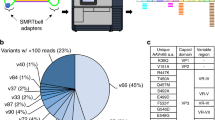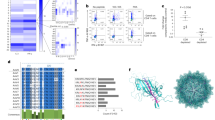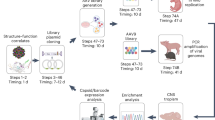Abstract
The human parvovirus adeno-associated virus type 2 (AAV2) has many features that make it attractive as a vector for gene therapy1,2. However, the broad host range of AAV2 might represent a limitation for some applications in vivo, because recombinant AAV vector (rAAV)-mediated gene transfer would not be specific for the tissue of interest. This host range is determined by the binding of the AAV2 capsid to specific cellular receptors and/or co-receptors3,4,5,6. The tropism of AAV2 might be changed by genetically introducing a ligand peptide into the viral capsid, thereby redirecting the binding of AAV2 to other cellular receptors. We generated six AAV2 capsid mutants by inserting a 14-amino-acid targeting peptide, L14, into six different putative loops of the AAV2 capsid protein identified by comparison with the known three-dimensional structure of canine parvovirus. All mutants were efficiently packaged. Three mutants expressed L14 on the capsid surface, and one efficiently infected wild-type AAV2-resistant cell lines that expressed the integrin receptor recognized by L14. The results demonstrate that the AAV2 capsid tolerates the insertion of a nonviral ligand sequence. This might open new perspectives for the design of targeted AAV2 vectors for human somatic gene therapy.
This is a preview of subscription content, access via your institution
Access options
Subscribe to this journal
Receive 12 print issues and online access
$209.00 per year
only $17.42 per issue
Buy this article
- Purchase on Springer Link
- Instant access to full article PDF
Prices may be subject to local taxes which are calculated during checkout



Similar content being viewed by others
References
Kotin, R.M. Prospects for the use of adeno-associated virus as a vector for human gene therapy. Hum. Gene Ther. 5, 793– 801 (1994).
Hallek, M. et al. Recombinant adeno-associated virus vectors. IDrugs 1, 561–573 ( 1998).
Mizukami, H., Young, N.S. & Brown, K.E. Adeno-associated virus type 2 binds to a 150-kilodalton cell membrane glycoprotein. Virology 217, 124–130 (1996).
Summerford, C. & Samulski, R.J. Membrane-associated heparan sulfate proteoglycan is a receptor for adeno-associated virus type 2 virions. J. Virol. 72, 1438–1445 (1998).
Summerford, C., Bartlett, J.S. & Samulski, R.J. αVβ5 integrin: a co-receptor for adeno-associated virus type 2 infection. Nature Med. 5, 78 –82 (1999).
Qing, K. et al. Human fibroblast growth factor receptor 1 is a co-receptor for infection by adeno-associated virus 2. Nature Med. 5, 71–77 (1999).
Hermonat, P.L., Labow, M.A., Wright, R., Berns, K.I. & Muzyczka, N. Genetics of adeno-associated virus: isolation and preliminary characterization of adeno-associated virus type 2 mutants. J. Virol. 51, 329–339 ( 1984).
Tratschin, J.D., Miller, I.L. & Carter, B.J. Genetic analysis of adeno-associated virus: properties of deletion mutants constructed in vitro and evidence for an adeno-associated virus replication function. J. Virol. 51, 611–619 (1984).
Ruffing, M., Heid, H. & Kleinschmidt, J.A. Mutations in the carboxy terminus of adeno-associated virus 2 capsid proteins affect viral infectivity: lack of an RGD integrin-binding motif. J. Gen. Virol. 75, 3385– 3392 (1994).
Tsao, J. et al. The three-dimensional structure of canine parvovirus and its functional implications. Science 251, 1456 –1464 (1991).
Geourjon, C. & Deléage, G. OPM: a self-optimized method for protein secondary structure prediction. Protein Eng. 7, 157–164 (1994).
Thompson, J.D., Higgins, D.G. & Gibson, T.J. CLUSTAL W: improving the sensitivity of progressive multiple sequence alignment through sequence weighting, position-specific gap penalties and weight matrix choice. Nucleic Acids Research 22, 4673–4680 ( 1994).
Aumailley, M., Gerl, M., Sonnenberg, A., Deutzmann, R. & Timpl, R. Identification of the Arg-Gly-Asp sequence in laminin A chain as a latent cell-binding site being exposed in fragment P1. FEBS Lett. 262, 82–86 ( 1990).
White, J.M. Integrins as virus receptors. Curr. Biol. 3, 596–599 (1993).
Valsesia-Wittmann, S. et al. Modifications in the binding domain of avian retrovirus envelope protein to redirect the host range of retroviral vectors. J. Virol. 68, 4609–4619 (1994).
Wistuba, A., Kern, A., Weger, S., Grimm, D. & Kleinschmidt, J.A. Subcellular compartimentalization of adeno-associated virus type 2 assembly. J. Virol. 71, 1341 –1352 (1997).
Stewart, P.L. et al. Cryo-EM visualization of an exposed RGD epitope on adenovirus that escapes antibody neutralization. EMBO J. 16, 1189–1198 (1997).
Yang, Q. et al. Development of novel cell surface CD34-targeted recombinant adenoassociated virus vectors for gene therapy. Hum. Gene Ther. 9, 1929–1937 ( 1998).
Bartlett, J.S., Kleinschmidt, J.A., Boucher, R.C. & Samulski, R.J. Targeted adeno-associated virus vector transduction of nonpermissive cells mediated by a bispecific F(ab'γ)2 antibody. Nat. Biotech. 17, 181–186 ( 1999).
Smith, T.F. & Waterman, M.S. Identification of common molecular subsequences. J. Mol. Biol. 147, 195– 197 (1981).
Kabsch, W. & Sander, C. Dictionary of protein secondary structure: pattern recognition of hydrogen-bonded and geometrical features. Biopolymers 22, 2577–2637 (1983).
Samulski, R.J., Chang, L.S. & Shenk, T. A recombinant plasmid from which an infectious adeno-associated virus genome can be excised in vitro and its use to study viral replication. J. Virol. 61, 3096– 3101 (1987).
Chiorini, J.A. et al. High-efficiency transfer of the T cell co-stimulatory molecule B7-2 to lymphoid cells using high-titer recombinant adeno-associated virus vectors. Hum. Gene Ther. 6, 1531– 1541 (1995).
Carrel, S., Sordat, B. & Merenda, C. Establishment of a cell line (Co-115) from a human colon carcinoma transplanted into nude mice. Cancer Res. 36, 3978–3984 (1976).
Acknowledgements
We thank I. Renner-Müller and E. Wolf for their help and providing their animal facilities to produce rabbit antiserum against L14. This work was supported by grants from the Wilhelm-Sanderstiftung, Bayerische Forschungsstiftung, and the Deutsche Forschungsgemeinschaft (Sonderforschungsbereich 455) (M.H. and A.G.) and stipends of the Studienstiftung des Deutschen Volkes and the Fond der Chemischen Industrie (BMBF) (M.R.).
Author information
Authors and Affiliations
Corresponding author
Rights and permissions
About this article
Cite this article
Girod, A., Ried, M., Wobus, C. et al. Genetic capsid modifications allow efficient re-targeting of adeno-associated virus type 2. Nat Med 5, 1052–1056 (1999). https://doi.org/10.1038/12491
Received:
Accepted:
Issue Date:
DOI: https://doi.org/10.1038/12491
This article is cited by
-
Technological advances in the use of viral and non-viral vectors for delivering genetic and non-genetic cargos for cancer therapy
Drug Delivery and Translational Research (2023)
-
AAV capsid variants with brain-wide transgene expression and decreased liver targeting after intravenous delivery in mouse and marmoset
Nature Neuroscience (2022)
-
Variants of the adeno-associated virus serotype 9 with enhanced penetration of the blood–brain barrier in rodents and primates
Nature Biomedical Engineering (2022)
-
Lasso-grafting of macrocyclic peptide pharmacophores yields multi-functional proteins
Nature Communications (2021)
-
Adeno-associated virus vector as a platform for gene therapy delivery
Nature Reviews Drug Discovery (2019)



